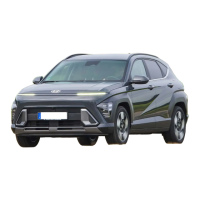
Do you have a question about the Hyundai KONA Hybrid and is the answer not in the manual?
| Brand | Hyundai |
|---|---|
| Model | KONA Hybrid |
| Category | Automobile |
| Language | English |
Procedures to disable the vehicle's systems using the smart key and START/STOP button.
Understanding power button states and disconnecting the 12V auxiliary battery connector.
Locating the high voltage cut-off switch and understanding electrocution risks. Wait 5 mins for discharge.
Strict precautions for firefighting due to lithium-ion battery risks, potential for re-ignition, and required PPE.
Using ABC extinguishers for small fires and large amounts of water for high voltage battery fires.
Methods for extinguishing vehicle fires, including using large volumes of water and neutralizing battery damage.
Procedures for neutralizing battery leaks with water and precautions for electrolyte irritation.
Mitigating stranded energy risks by ensuring the battery is cooled and following depowering procedures.












